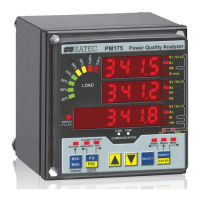Chapter 4 PAS Application Software
Power block
demand period
1, 2, 3, 5, 10, 15,
20, 30, 60 min,
E=external sync
The length of the demand period for
power demand calculations. If the
external synchronization is selected, a
pulse front on the digital input DI1
denotes the start of the demand
interval.
Number of blocks in
sliding demand
The number of blocks to be averaged
for sliding window demands
Volt/Ampere/THD
demand period
The length of the demand period for
ampere, volt and THD demand
calculations
1
PT Ratio is defined as a relation of the potential transformer’s
primary voltage rating to its secondary rating. For example, for the
14,400 V transformer’s primary rating and 120 V secondary rating, the
PT Ratio = 14400/120 = 120.
Available wiring modes are listed in the following table.
3-wire Open Delta using 2 CTs (2 element)
4-wire Wye using 3 PTs (3 element), line-to-neutral voltage readings
3-wire Direct Connection using 2 CTs (2 element)
4-wire Wye using 3 PTs (3 element), line-to-line voltage readings
3-wire Open Delta using 3 CTs (2½ element)
4-wire Wye using 2 PTs (2½ element), line-to-neutral voltage readings
4-wire Wye using 2 PTs (2½ element), line-to-line voltage readings
3-wire Broken Delta using 2 PTs, 3 CTs (2½-element), line-to-neutral
voltage readings
3-wire Broken Delta using 2 PTs, 3 CTs (2½-element), line-to-line voltage
readings
In 4LN3, 3LN3 and 3BLN3 wiring modes, the voltage
readings for min/max volts and volt demands represent line-to-
neutral voltages; otherwise, they will be line-to-line voltages.
The voltage waveforms and harmonics in 4LN3, 3LN3 and
3BLN3 wiring modes represent line-to-neutral voltages;
otherwise, they will be line-to-line voltages.
Device Options
This setup allows you to enable or disable optional
calculations and redefine user-selectable device options.
To enter the setup dialog, select the device site from the list
box on the PAS toolbar, select General Setup from the Meter
Setup menu, and then click on the Device Options tab.

